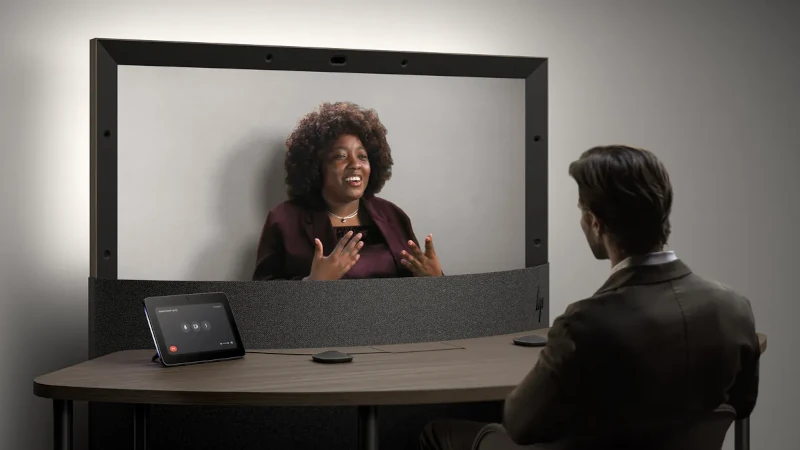I was fortunate to participate in a demo of Project Starline at the ISE 2025 show in Barcelona (thank you Google for your hospitality), and it was impressive.
Perfect Eye Contact Telepresence
For those of you who haven’t seen it, Project Starline is a modern-day – and much improved – version of the true eye-contact telepresence solutions that have been available on the market for more than a decade from companies such as DVE Telepresence, the now defunct TelePresence Tech and Teliris, and others.
While the form factors and price points varied, these solutions each offered superior eye contact, usually by placing the camera behind the display using the pepper’s ghost technique (see Wikipedia’s explanation) or some other methodology.
By providing “true” eye contact, these solutions created a stronger feeling of connectedness between the participants. Some of these solutions also included special lighting and camera technology to add a feeling of depth to the experience.
These systems lived up to their promise of offering a next-level virtual experience that fosters trust and bonding between the participants. However, their high cost relegated them to a handful of specific use cases (e.g., telepsychology, very high profile meetings, HR recruitment, etc.) where perfect eye contact could make the difference between success and failure.
[ To be clear, I’m not saying that eye contact doesn’t matter. It absolutely does. That said, IMHO, the “face contact” offered by standard video conferencing systems is acceptable for most situations. Based on the limited market success of these legacy eye-contact telepresence offerings, the market apparently agrees with me. ]
What Makes Project Starline Different?
Project Starline introduces a few new twists to the perfect eye contact video conferencing category.
A New Approach to Eye ContactProject Starline uses multiple cameras to capture the local participants. Google then uses cloud-based AI to combine those video streams into a single stream with enhanced (almost perfect) eye contact that is then sent to the remote participants.
This approach offers numerous benefits over the old-school, hardware-based approaches, including:
- It provides true eye contact without the cost, complexity, and time-consuming setup of mirrors and prisms
- It allows the system to fit in a much smaller space than the legacy solutions
- It’s compatible with standard video conferencing hardware and various calling services
Project Starline uses a light field display to provide a three-dimensional experience without the need for special glasses.
Simply stated, light field displays release light rays from different positions and in different directions. This approach simulates how light naturally enters our eyes in the real world, leveraging our visual system’s natural ability to process depth and dimensionality (3D).
Another benefit of this approach is that multiple viewers can enjoy the 3D experience simultaneously.
Unfortunately, at least today, light field displays are extremely expensive.
Deciphering the Project Starline Demo
The demo at ISE 2025 was exceptional to say the least. The 3D experience was “reach out and touch” perfect, and the eye contact was eerily good.
Unfortunately, the audio experience was sub-par. According to Google folks onsite, the production version of Starline (powered by HP technology) will provide far better audio. I have no doubt this will be the case.
The net is that from a video experience perspective, this demo was an AI-powered slam dunk.
The Expected Go-To-Market
Despite its differentiated experience, our understanding from discussions at ISE is that Project Starline’s go-to-market will be somewhat traditional.
- HP will be the OEM hardware partner for the solution, which means Starline will include HP / Poly cameras, an HP / Poly video conferencing system, and an HP / Poly touch controller.
- Each system will require a Google Starline license.
- The hardware and license will be sold by AV and IT channel partners, who will also install and configure the system.
- The system will initially support Google Meet, but Zoom support is expected to arrive a few weeks later. (FYI – when used in a Zoom environment, the Starline endpoint and touch controller will use the standard Zoom Rooms user interface.)

(picture courtesy of Google)
The Achilles Heel of Starline
Strangely enough, the primary weakness of Project Starline is not product related – it stems from market demand (or the likely lack thereof).
Project Starline offers an exceptional and highly differentiated experience, and I expect some Google or HP customers will purchase a handful of units, almost regardless of price or even need. If it says Google on the label, someone will buy it.
However, the reality is that the typical video conferencing customer does not need this next-level experience to do their job. Combine the limited customer need with what we expect will be a hefty price tag per unit, and we’re left wondering just how many customers will jump on board.
What is the Measurement of Success?
Finally, we can’t help but wonder what Google and HP are expecting from Project Starline.
If this product is intended to demonstrate the engineering prowess of these two companies, that mission has been accomplished. If the idea is to highlight the strength of the Google / HP partnership, that’s a roger as well.
However, if their goals include selling tens of thousands of units, we’re far more skeptical. Hopefully, they’ll prove us wrong.
In the meantime, kudos to Google and HP for pushing the boundaries of visual communication.

